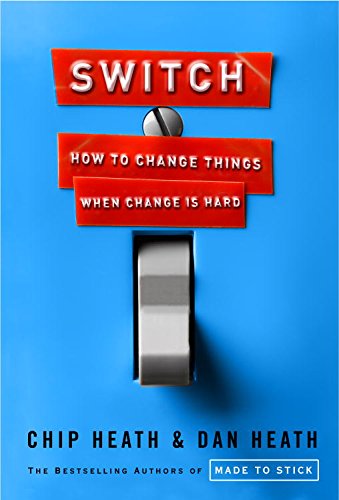
Here we’ve got a professor of organizational management and a high-powered management consultant, both young (at least from the perspective of my advanced age), who can actually write in an engaging and entertaining way—and they deliver a message that is truly both profound and practical. Switch is one of the most useful books for managers written in recent years. Combine it with another excellent recent book, Drive by Daniel Pink (reviewed earlier in this blog), and you’ve got an unbeatable set of tools for anyone faced with the need to engineer change in a business, nonprofit, or government.
What is most remarkable about Switch, aside from the authors’ amusing style, is the profusion of fascinating examples drawn from a wide variety of sources, from academics in many disparate fields to self-help literature to personal experiences. However, unlike the authors of most how-to literature, the brothers Chip Heath and Dan Heath refer again and again to examples cited earlier in the book, deepening the reader’s understanding and making it far more likely that she’ll recall at least some of these fascinating stories.
Switch: How to Change Things When Change Is Hard by Chip Heath and Dan Heath ★★★★★
Switch can serve as model for writers of how-to books (and I ought to know, having written a slew of them myself).
As the subtitle makes clear, Switch is about how to bring about change — in an organization, in a spouse or coworker, or in yourself. The book is organized into three principal sections, corresponding to the three dimensions of successful change-making: the intellectual (referred to here as The Rider), the emotional (here, The Elephant), and the specific course of action (The Path).
This concept is based on the image of a person riding atop an elephant and trying to persuade it to move onto an unfamiliar course — a daunting proposition, as you might imagine. In each of the three sections, the authors cite a substantial number of examples to illustrate the significance of respecting these three elements. Additional examples tie all three together by showing how individual people have successfully engineered change — often very far-reaching change in business or government — by pursuing an approach based on an intuitive understanding of the three dimensions. Fascinating!
Just in case you didn’t notice: the brothers Heath collaborated on another excellent and useful book three years ago: Made to Stick: Why Some Ideas Survive and Others Die.
For additional reading
This is one of the Best books about innovation reviewed here.
Like to read books about business? Check out My 10 favorite books about business history.
If you enjoy reading nonfiction in general, you might also enjoy:
- Science explained in 10 excellent popular books
- Great biographies I’ve reviewed: my 10 favorites
- Top 10 nonfiction books about politics
And you can always find my most popular reviews, and the most recent ones, plus a guide to this whole site, on the Home Page.



























